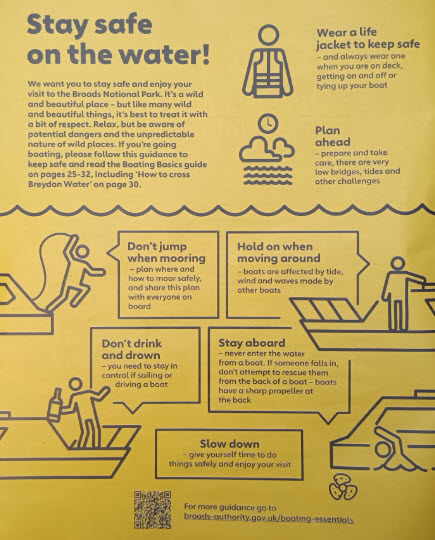Safety
From the Broads Authority:
Always wear a life jacket at all times if you are canoeing/kayaking/paddleboarding, whilst on boats, while getting on and off vessels and when close to the water's edge. Wear sensible clothing and shoes for your chosen activity.
Put a life jacket on your pet.
If you fall into the water, try to float to live by fighting the urge to thrash around. Lean back and extend your arms and legs, gently move them around to help you float if you need to, float until you can control your breathing, then call 999 for help or swim to safety.
Keep a close eye on children who can fall overboard without anyone noticing.
We don't advise you to swim, as there are risks from cold water, currents and boats.
Don't jump off a moving boat and don't sit on the front deck of a day boat.
Don't try to stop your boat by pushing with your hand or foot.
Don't reverse your boat towards anyone in the water, and do not swim near the rear of motor boats, as that's where the propeller is. This will cause serious injury if it comes into contact with you.

River Rules
Everyone who uses the rivers, whether by paddle craft or motor cruiser, needs to follow some basic 'rules' to keep them and other visitors safe.
Keep near to the right-hand bank at all times (the opposite side to where you would drive on a road).
Stick to the speed limits on the Broads, which are indicated by signs on the river banks. Generally speaking, the speed limits vary between 3 mph and 6 mph.
Sailing boats always have the right of way. They may tack (zig-zag) across the water, and you should try to pass them as they move away from you.
In some areas, specific channels may be provided for your safety, meaning you must stay within that channel. These are marked by posts or buoys.
Taking personal safety
Know your alcohol limits. Drinking may make you more likely to fall in and reduce your chances of surviving if you do.
Check the height of your boat when approaching bridges and make sure you are aware of the amount of clearance. Keep your hands and head inside the boat until you are well clear of the bridge.
Never drink water from rivers or lakes, and don't splash it onto your face to cool down.
If you do get wet, try to wash or shower promptly. Also, remember to wash and thoroughly dry any wet clothing before wearing it again.
Keep away from water which is discoloured or where you see foam, scum or algae as it may be toxic.
Knowing your location using 'what3words'
Before exploring the park and going off the beaten track, it’s important to ensure you know your route, have packed the correct equipment and checked the weather forecast. Another simple step to take before heading off is to make sure you’ve downloaded the free what3words app.
What3words is an addressing system that gives every 3m square in the world a unique three-word identifier. It allows you to communicate any precise location using just three words. For example,///munched.multiply.tasks is an exact spot along the popular Weaver’s Way walking route.
What3words is used by emergency services in Norfolk and Suffolk to locate callers. So if you find yourself in trouble in a hard-to-describe or unknown location, you can open the app and read the three words for your current location to help 999 know exactly where you are.
Find out more about what3words: Watch Here
Install it on your phone ASAP - great for directing delivery drivers, etc. to your home!